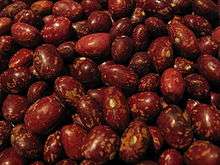Pinto bean
 | |
| Nutritional value per 100 g | |
|---|---|
| Energy | 598 kJ (143 kcal) |
|
26.22 | |
| Sugars | 0.34 |
| Dietary fiber | 9.0 |
|
0.65 | |
| Saturated | 0.109 |
| Trans | 0 |
| Monounsaturated | 0.106 |
| Polyunsaturated | 0.188 |
|
9.01 | |
| Vitamins | Quantity %DV† |
| Vitamin A equiv. |
0% 0 μg |
| Vitamin A | 0 IU |
| Thiamine (B1) |
17% 0.193 mg |
| Riboflavin (B2) |
5% 0.062 mg |
| Niacin (B3) |
2% 0.318 mg |
| Vitamin B6 |
18% 0.229 mg |
| Folate (B9) |
43% 172 μg |
| Vitamin B12 |
0% 0 μg |
| Vitamin C |
1% 0.8 mg |
| Vitamin D |
0% 0 μg |
| Vitamin D |
0% 0 IU |
| Vitamin E |
6% 0.94 mg |
| Vitamin K |
3% 3.5 μg |
| Minerals | Quantity %DV† |
| Calcium |
5% 46 mg |
| Iron |
16% 2.09 mg |
| Magnesium |
14% 50 mg |
| Phosphorus |
21% 147 mg |
| Potassium |
9% 436 mg |
| Sodium |
16% 238 mg |
| Zinc |
10% 0.98 mg |
| Other constituents | Quantity |
| Water | 62.95 g |
| |
|
†Percentages are roughly approximated using US recommendations for adults. Source: USDA Nutrient Database | |
The pinto bean (/ˈpɪntoʊ/) is a variety of the common bean (Phaseolus vulgaris).
It is the most popular bean in the United States[1] and northwestern Mexico, and is most often eaten whole in broth or mashed and refried. Either whole or mashed, it is a common filling for burritos. The young pods may also be harvested and cooked as green pinto beans.
In Spanish, they are called frijol pinto [fri.ˈxol ˈpin.to], literally "speckled bean" (compare pinto horse), and in South America it is known as the poroto frutilla, literally "strawberry bean". In Portuguese, they are called feijão carioca in Brazil (literally "carioca bean") and feijão catarino in Portugal.
Use
The pinto bean is the bean commonly used fresh or canned in many dishes, especially refried beans. It is popular in chili con carne, although kidney beans, black beans, and many others may be used in other locales.
Pinto beans are found in Brazilian cuisine. Legumes, mainly the common bean, are a staple food everywhere in the country, cultivated since 3000 BC, along with starch-rich foods, such as rice, manioc, pasta, and other wheat-based products, polenta and other corn-based products, potatoes and yams.
In the Southern United States, pinto beans were once a staple, especially during the winter months. Some organizations and churches in rural areas still sponsor "pinto bean suppers" for social gatherings and fund raisers.
Varieties

Pinto bean varieties include: 'Burke', 'Hidatsa', and 'Othello'.
The alubia pinta alavesa, or the "Alavese pinto bean", a red variety of the pinto bean, originated in Añana,[2] a town and municipality located in the province of Álava, in the Basque Country of northern Spain. In October, the Feria de la alubia pinta alavesa (Alavese pinto bean fair) is celebrated in Pobes.[3]
Nutrition
A nutrient-dense legume, the pinto bean contains many essential nutrients and is very low in saturated fat. It is a good source of protein, phosphorus and manganese, and very high in dietary fiber and folate.[4]
Rice and pinto beans served with cornbread or corn tortillas are often a staple meal where meat is unavailable. This combination contains the essential amino acids necessary for humans in adequate amounts[5]: corn complements beans' relative scarcity of methionine and cystine and beans complement corn's relative scarcity of lysine and tryptophan.[6]
Studies have indicated pinto beans can lower the levels of both HDL and LDL cholesterol.[7][8] Pinto beans have also been shown to contain the phytoestrogen coumestrol, which has a variety of possible health effects.[9]
References
- ↑ "Maize 2003 CGC Meeting". Ars-grin.gov. Archived from the original on 2012-09-15. Retrieved 2012-01-14.
- ↑ Recetas para acordarse de sabores perdidos: "Añana. Es el origen de la alubia pinta alavesa y, como tal, esta legumbre pesa en su cocina. Ya sea en cocido, crema o sopa. El queso Idiazábal o el conejo son otros de sus manjares." (Spanish)
- ↑ Algunas de las ferias tradicionales en Euskadi: "La Feria de la alubia pinta alavesa, que se celebra en octubre en la localidad de Pobes." (Spanish)
- ↑ "Beans, pinto, mature seeds, cooked, boiled, with salt". Nutrition Facts. Retrieved 16 January 2016.
- ↑ Essential Amino Acids. phy-astr.gsu.edu: "Tillery points out that a number of popular ethnic foods involve such a combination, so that in a single dish, one might hope to get the ten essential amino acids. Mexican corn and beans, Japanese rice and soybeans, and Cajun red beans and rice are examples of such fortuitous combinations."
- ↑ Food and agriculture organization of the United Nations (1992). "Chapter 8 - Improvement of maize diets". Maize in human nutrition.
- ↑ "Pinto bean consumption changes SCFA profiles in fecal fermentations, bacterial populations of the lower bowel, and lipid profiles in blood of humans". J. Nutr. 137 (11): 2391–8. November 2007. PMID 17951475.
- ↑ "Pinto Bean Consumption Reduces Biomarkers for Heart Disease Risk". Jacn.org. Retrieved 2012-01-14.
- ↑ Bhagwat, Seema; Haytowitz, David; Holden, Joanne (September 2008). USDA Database for the Isoflavone Content of Selected Foods (PDF) (Release 2.0 ed.). Beltsville, Maryland: U.S. Department of Agriculture. Retrieved 10 March 2015.
External links
- Texas style pinto bean recipe -- becomecook.com recipes

